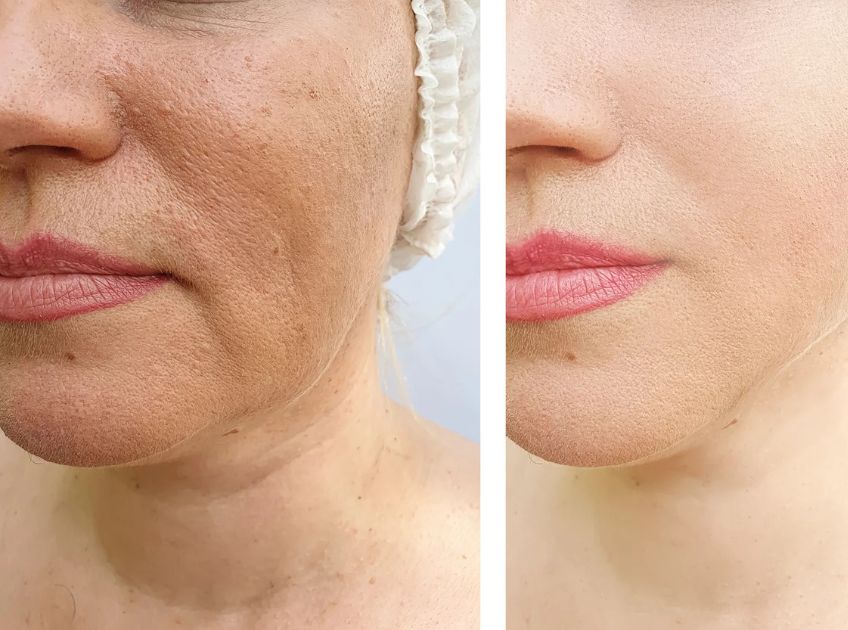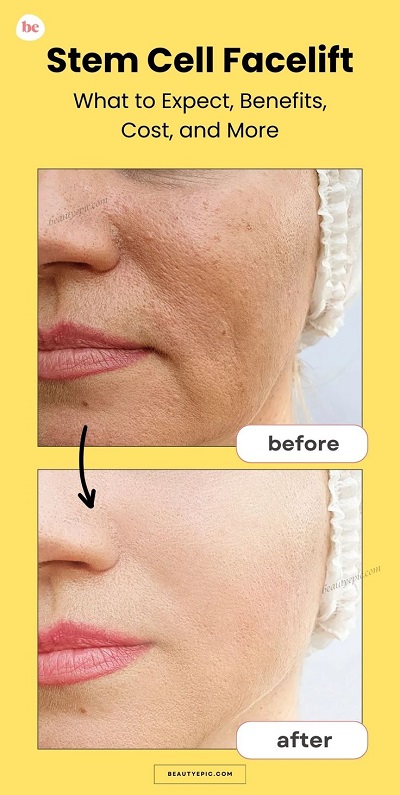
Important: This article is for informational purposes only. Please read our full disclaimer for more details.
Tired of traditional facelifts and their long recovery times? The stem cell facelift is emerging as a game-changing, minimally invasive alternative that rejuvenates the skin from within. This procedure uses your body’s regenerative cells to restore volume, improve elasticity, and reduce signs of aging—without going under the knife.
If you’re curious about what this procedure involves, who it’s for, and whether it’s safe, this expert guide will walk you through everything you need to know.
What Is a Stem Cell Facelift?
A stem cell facelift is a non-surgical cosmetic procedure that combines fat grafting with the regenerative properties of stem cells derived from your own body, typically from fat harvested via liposuction (1). These cells are re-injected into specific facial areas to enhance volume, improve skin texture, and stimulate collagen production.
Unlike a surgical facelift that cuts and tightens skin, this method focuses on revitalizing skin health from the inside out.
Why People Are Choosing the Stem Cell Facelift
Stem cell facelifts are gaining traction for several compelling reasons:
- Natural-looking results that avoid the “pulled” look of traditional facelifts.
- Improved skin tone and texture due to increased collagen and elastin production.
- Minimally invasive procedure with shorter downtime and fewer complications.
- Uses your own fat and stem cells, reducing the risk of allergic reactions or rejection.
- Long-term anti-aging effects occur as stem cells continue to rejuvenate skin over time.
According to a study in the Aesthetic Surgery Journal (2014), autologous fat grafting enriched with stem cells showed improved volume retention and skin quality compared to fat grafting alone (2).
Stem Cell Facelift vs. Traditional Facelift: What’s the Difference?
| Factor | Stem Cell Facelift | Traditional Facelift |
|---|---|---|
| Invasiveness | Minimally invasive | Surgical (incisions required) |
| Downtime | Minimal (a few days) | 2–3 weeks or more |
| Scarring | No visible scarring | Potential scarring behind the ears |
| Results | Gradual, natural rejuvenation | Immediate lift |
| Longevity | Several years with touch-ups | 5–10 years |
| Skin Quality Boost | Yes (collagen regeneration) | No direct skin quality improvement |
Who Is the Ideal Candidate?
While results vary, the stem cell facelift works best for:
- Individuals aged 35–60 with mild to moderate signs of aging.
- Those with early volume loss, sagging, or dull skin.
- People who want natural-looking enhancement without surgery.
- Patients with good overall health and realistic expectations.
It’s not ideal for those with very loose skin or advanced aging signs—surgical facelifts may still be more effective in such cases.
Are There Any Side Effects?
Like all cosmetic procedures, a stem cell facelift does carry some potential side effects:
- Swelling and bruising at injection or liposuction sites (temporary)
- Mild pain or discomfort for a few days
- Infection risk, although rare when performed by a licensed expert
- Uneven fat absorption may lead to asymmetry
- Fat necrosis or lumps, though uncommon, can occur with the proper technique
Always consult a board-certified cosmetic surgeon with experience in regenerative therapies.
Aftercare Tips for a Smooth Recovery
Proper aftercare ensures the best results and minimal side effects:
- Apply cold compresses to reduce swelling in the first 48 hours.
- Avoid intense facial movements for at least a week.
- Sleep on your back with your head elevated for 3–5 days.
- Stay hydrated and eat nutrient-rich foods to support healing.
- Limit sun exposure and avoid harsh skin products for 2 weeks.
Your doctor may also recommend follow-up visits or PRP (Platelet-Rich Plasma) boosters to enhance results.
What’s the Cost of a Stem Cell Facelift?
The cost of a stem cell facelift in the U.S. generally ranges from $5,000 to $15,000, depending on:
- The surgeon’s expertise and clinic location
- The amount of fat harvested and processed
- Use of additional technologies like PRP or micro-needling
While it may be more expensive than fillers, the longer-lasting and regenerative effects often justify the price for many.
Scientific Backing and Credibility
Stem cells have shown potential in aesthetic medicine due to their regenerative properties. A 2020 study published in the International Journal of Molecular Sciences emphasized the effectiveness of adipose-derived stem cells in tissue repair and anti-aging applications (3). However, long-term studies are still ongoing, and results can vary widely based on the technique and patient biology.
Always ask your provider about the source, handling, and safety of the stem cells used.
Frequently Asked Questions (FAQ’S)
Q1. How long do results from a stem cell facelift last?
A. Most patients enjoy noticeable results for 2–5 years, with some requiring minor touch-ups depending on age, skin condition, and lifestyle habits.
Q2. Can I combine it with other cosmetic treatments?
A. Yes. It’s often paired with microneedling, PRP, or laser resurfacing to enhance skin tone and elasticity.
Q3. Is there any downtime?
A. Downtime is minimal. Most people return to daily activities within 2–4 days, though some swelling or bruising may last up to a week.
Final Thoughts: Is the Stem Cell Facelift Worth It?
If you’re seeking a natural, non-surgical way to rejuvenate your face, a stem cell facelift could be the modern solution you’re looking for. With regenerative power, minimal downtime, and long-term benefits, it blends science and aesthetics to deliver subtle yet transformative results.
Note: Before you proceed, always consult a qualified, board-certified provider and weigh your options carefully. When done right, this innovative procedure could be your best investment in youthful, radiant skin.
















